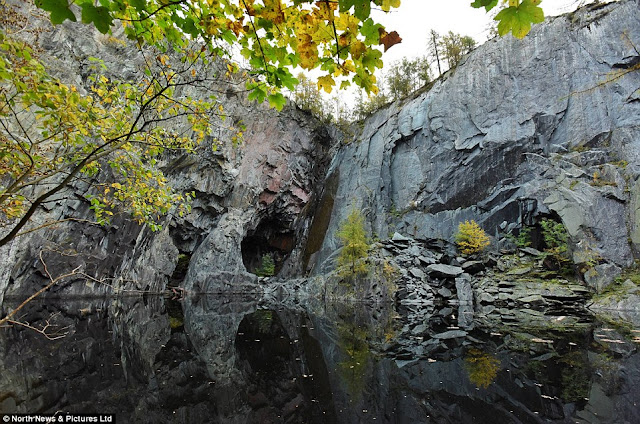The
frightening sight of a massive skull has been spotted in the rocks of a remote
area of the Lake District which is believed to have claimed the lives of
countless divers. The terrifying cliff face and its eerie reflection in the
waters of the lake create mysterious illusion of a sinister skull on its side
emerging from the darkness. Therefore, the hunting picture can be visible in
the still water of disused Hodge Close slate quarry near Coniston in Cumbria.
Thus, the abandoned quarry, which is 70 metres deep from the surface and has a
20 metres deep lake, is pierced with underwater tunnels. Hence, the quarry was
an open pit from the 19th century to the early 1960s which has now flooded over
time. Nowadays, this place is well known in divers and abseilers who’re keen to
climb the rock face, though access to the water involves wading through a 120
metres flooded tunnel and down a scaffolding ladder. Several legends believe,
that the lake has claimed the lives of quite a few divers over the years that
have gotten lost in the tunnels.
A
45-year-old man had to be rescued after falling 20ft while abseiling in the
quarry in 2012. He was rescued during a hardworking two-hour operation by a
team of 20 members of Coniston Mountain Rescue Team. So, no one knows how many
people have seen or noticed the skull. Therefore, it is only really becomes
visible when the water is flat calm, and you look at the view sideways. You
also need to be down next to the water, which isn't a trip everyone would want
to make. Though, the quarry stopped working in the early-to-mid 20th Century,
and is a prevalent climbing and diving venue. It is frequently used as an
abseiling location by outdoor instructors. There’s stillness and a very eerie
atmosphere around the place. The area is uses for training for various aspects
of rope rescue and familiarization to allow us to respond effectively to
incidents at the quarry and can't see the skull reflection from the top you
have to scramble down to the pit of the quarry and walk to the water’s edge to
see it. When you look at the reflection of the skull in the deep dark water,
it's quite chilling. However, bearing in mind the status of the area, it is a
very worrying moment when the skull appears out of nowhere with crystal
clarity.







































